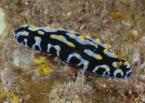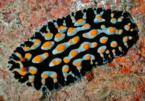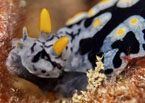| Home |
| Acknowledgments |
| Conventions |
| Glossary |
| Maps |
| References |
| Links |
| Articles |
| Thumbnails |
| Species
list |
| Family |
| Next
species |
Additional Photos

underside

side

rhinophores

gray margin

little yellow

oral tentacles

pair

feeding?

Phyllidia sp. #1

| Maximum size: 42 mm. Identification: This phyllidiid is elongate-oval with three longitudinal ridges that may be composed of either fused or discontinuous, simple tubercles. The background color is black and the tubercles are capped with dark yellow and ringed with blue-gray basally. Crescent-shaped blue-gray areas containing black spots and yellow-capped tubercles are usually present around the mantle margin. Rarely, the yellow caps may be largely absent. The rhinophores are yellow and the foot is uniformly gray. It can be distinguished from the much more common Phyllidia varicosa by the lack of a dorsal anus, simple instead of compound tubercles, lack of a black medial stripe on the ventral surface of the foot and the dark yellow caps on it's tubercles. It can be distinguished from Phyllidia exquisita by the lack of a dorsal anus and marginal yellow line. Natural history: Phyllidia sp. #1 is rarely found on rocky bottoms in moderately exposed locations at depths of 6-24 m (20-79 ft). It may feed on a burnt-orange sponge. Distribution: Big Island, Maui, Molokai, Oahu and Kauai. Taxonomic notes: This species was formerly placed in the genus Fryeria due to its lack of a dorsal anus. However Fryeria has now be synonymized with Phyllidia. It was first recorded in Hawaii from Molokini Islet, Maui by PF in Nov. 1993. Photo: PF: 42 mm & 29 mm: Mokuho‘oniki, Molokai; Sept. 9, 1996. Observations and comments: Note 1: ( ) |
| Thumbnails |
Species
list |
Family | Next species | Top |